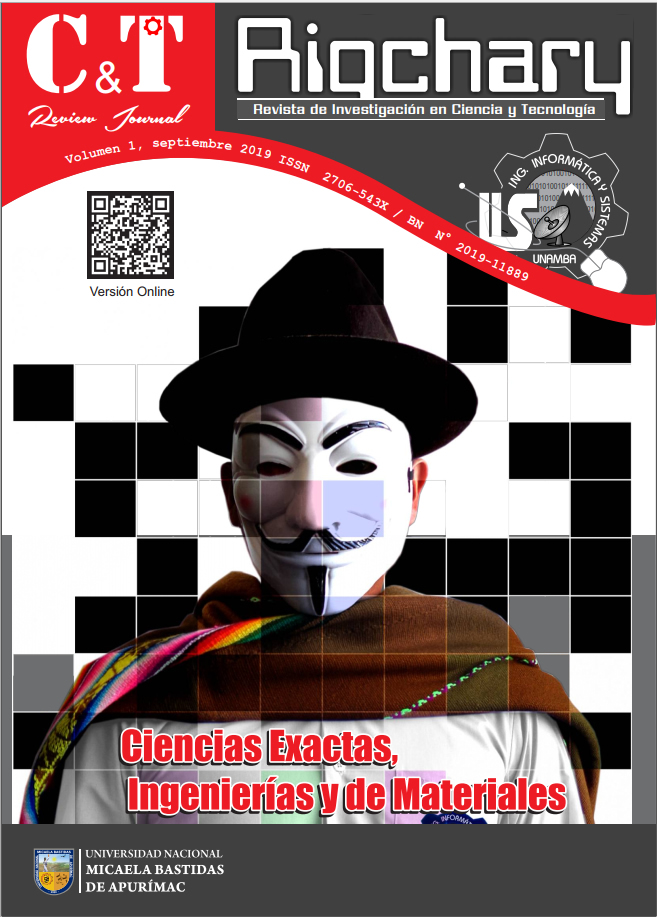Analysis of the Corn Dehydration Process (Zea Mays) in a Fluidized Bed Dryer
Contenido principal del artículo
Resumen
The present work was developed in the Department of Apurímac, Province of Abancay, in the Unitary Operations Laboratory of the Professional Academic School of Agroindustrial Engineering. The main objective of the research was to determine which mechanical elements influence the drying time. The problem in the dryers is the consumption of energy therefore the fans that drive the air are incorporated to reduce drying time and also increases the turbulence of the air but the expenditure of the electric power in higher, the research was developed to optimize the drying time in a fluidized bed dryer, JARCON, Model SLFT-60-240X, the method used for the determination of humidity is AOAC (2005) and the design applied was the complete random block (22 * 3) to evaluate the variables of answers, manipulating two factors such as the fan and extractor. The most important conclusions were, the shortest drying time resulted with the auxiliary equipment of the fan and extractor reaching a temperature of 36.9 oC with an average time of 14.7 hours, with the equation exponentially with a correlation coefficient of R2 of 0.9488 and secondly is when the fan operates at a temperature of 35.1 oC with a time of 16.8 hours with R2 of 0.9388.
Detalles del artículo

Esta obra está bajo una licencia internacional Creative Commons Atribución-NoComercial-SinDerivadas 4.0.
Cuando un autor crea un artículo y lo publica en una revista, los derechos de autor pasan a la revista como parte del acuerdo de publicación. Por lo tanto, la revista se convierte en la dueña de los derechos de reproducción, distribución y venta del artículo. El autor conserva algunos derechos, como el derecho a ser reconocido como el creador del artículo y el derecho a utilizarlo para sus propios fines académicos o de investigación, a menos que se acuerde lo contrario en el contrato de publicación.
Cómo citar
Referencias
J. Rodriguez, «http://www.cosechaypostcosecha.org,» 01 01 2006. [En línea]. Available: http://www.cosechaypostcosecha.org/data/folletos/FolletoSecadoGranos.pdf. [Último acceso: 03 09 2018].
E. Satorre, R. Benech, G. Slafer, E. De La Fuente, D. Miralles, M. Otegui y R. Savin, Producción de granos. Bases funcionales para su manejo, Argentina: Facultad de Agronomía de la Universidad de Buenos Aires, 2003.
A. &. B. G. Ibarz, Operaciones Unitarias en la Ingeniería de Alimentos, España: Mundi-Prensa, 2014.
A. S. Mujumdar, Manual de secado industrial, Londres Nueva York: CRC Press, 2015.
Á. H. Restrepo y J. C. Burbano, «Disponibilidad térmica solar y su aplicación en el secado de granos,» Scientia et Technica, vol. 12, nº 17, pp. 127-132, 2005.
M. Gur y M. Gur, «La comparación de maíz secado en secador de lecho fluido y convectiva bandeja Secadora,» Avances en la exergía, Energía y Medio Ambiente, vol. 1, nº 1, pp. 687-694, 2014.
M. A. Martinello, «Modelado del secado de granos en lecho fijo a bajas temperaturas de aire,» Universidad Nacional de La Plata, Argentina, 2015.
S. Revelo, «Rediseño del secador de granos proyecto senescyt TT-08-00001,» Escuela Politécnica Nacional en Ingeniería Mecánica, Quito Ecuador, 2016.
J. Wernecke y J. Wernecke, Humedad industrial y Medición-Una guía práctica, Alemania: Wiley-VCH Verlag GmbH & Co. KGaA, 2014.
P. Singh y D. Heldman, Introducción a la Ingeniería de los Alimentos, Zaragoza – España: Acribia, S.A. , 2014.
J. M. Delgado y . A. Barbosa de Lima, «Fenómenos de Transporte y el secado de sólidos y materiales particulados,» Biosystems Engineering, vol. 2, nº 92, p. 237–245, 2014.
G. V. Barbosa, H. Vega-Mercado y A. Ibarz Ribas, Deshidratación de alimentos, España: Acribia, 2000.
R. Bresani, C. Lezama, E. Gudiel, B. Rodas, C. Villatoro y G. Alvarado, «El uso de los productos agrícolas locales,» En el desarrollo de los alimentos complementarios, vol. 1, nº 17, p. 39, 2006.

